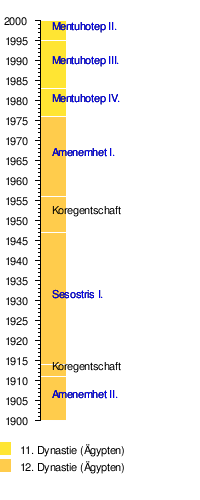List of rulers in the 20th century BC Chr.
Overview
22nd century BC Chr. | 21st century BC Chr. | List of rulers in the 20th century BC Chr. | 19th century BC Chr. | 18th century BC Chr.
More events
This is a synchronous representation of the reigns of pre-ancient rulers in the 20th century BC , visualized in the form of equally scaled timelines.
The dates follow medium chronology and are neither certain nor final nor complete. Please note general information!

Remarks
For the period 2000-1900 BC there are further details on rulers that are not listed here for various reasons. This includes mythical ancestral kings but also rulers who cannot be precisely fixed in time. See for example the lists of the kings of Ireland , Byblos , Argos , Sikyon , Ešnunna , Korea , Xia Dynasty . The kings of Elam are only partially reproduced here.
During the periods known as “co-regency”, father and son shared rulership over the land as kings of Egypt.
There is also a reference to Ilu-šūma that he is said to have fought with Sumu-abum , which Ilu-šūma would put a century later in the beginning of the 19th century BC. Lipit-Ištar and Gungunum were also contemporaries.
Deputies and viceroys are only listed here if the territory they administer formed an independent state before or afterwards.
General
In the timeline, a gap of one year symbolizes that the transition between two rulers will be assumed around this time. If the transition period can be determined more precisely, this is indicated by a thinner line. Larger gaps between two names do not necessarily mean that there was no ruler; but indicate an uncertainty. If no colored bars are displayed, the relevant rulers cannot be dated more precisely according to the latest research. The representation does not claim to be complete.
Specifically, the dating according to Nissen (2012) is used here for the information on ancient oriental kings and the dating according to Beckerath (1994) for the information on Egyptian kings. There are no reliable data for other parts of the world at this time, not even for China (compare chronological project Xia-Shang-Zhou ).
General note: Due to the problems with ancient oriental and Egyptian chronology, the information in this list has not been finalized. This is based on the Middle Chronology , which is commonly used as a convention among ancient orientalists. Specialist authors usually state which assumptions / chronologies their writings are based on: Depending on the opinion, the dating of great kings and pharaohs can be in the period before the 14th century BC. By several decades from the information used here.
Due to new archaeological findings, the state of research and current doctrine on dating can occasionally change abruptly. If more recent findings are incorporated, the simultaneity of rulers must be checked (this should be guaranteed according to archaeological evidence) and the chronology used and the source / place of discovery must be indicated.
Individual evidence
- ↑ a b Hans Jörg Nissen : History of the Ancient Near East . Oldenbourg Verlag, 2nd edition 2012, Munich. ISBN 3-486-59223-8 .
- ↑ Jürgen von Beckerath : Chronology of the Pharaonic Egypt. The timing of Egyptian history from prehistoric times to 332 BC BC (= Munich Egyptological Studies . Vol. 46). von Zabern, Mainz 1997.





